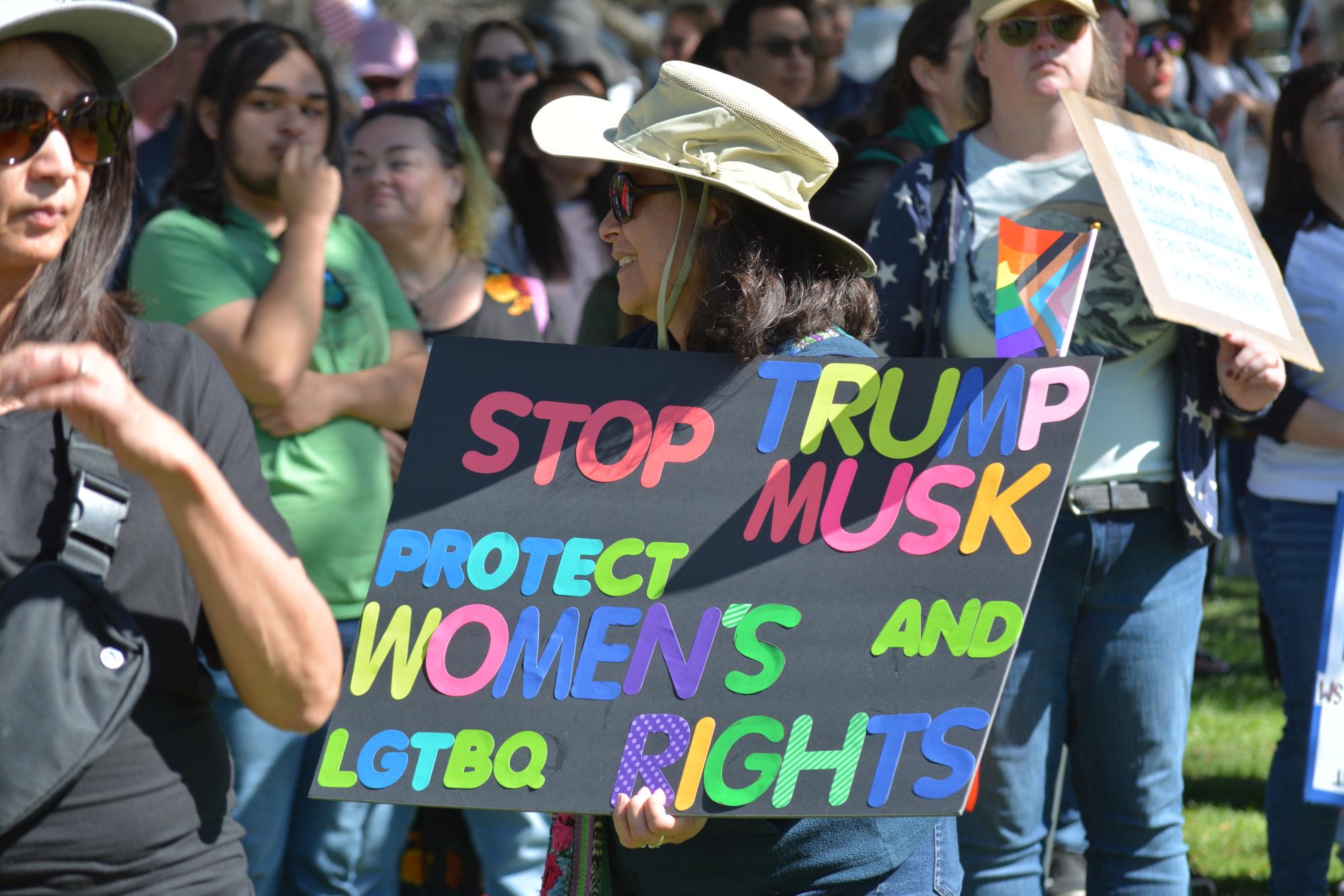Honoring Women’s History Month


The Supreme Court’s 1973 Roe v. Wade decision to legalize abortion nationwide was a landmark victory for women’s autonomy, reflecting a growing public support for gender equality at the time. Today, with Roe v. Wade overturned and increasing skepticism toward feminism, that momentum appears to be reversing.
“History moves along, for civil rights in particular, forward, and then there’s always moments of regression, but we usually come back around and move forward again,” history teacher and FEM Club adviser Donna Gilbert said. “The question is where we are on that sort of trajectory. At this point I believe we’ve sort of stopped and now we’re starting to move back, in terms of bodily autonomy.”
The fight for gender equality has never been smooth. From the suffragists of the early 20th century to the activists who fought for Roe v. Wade, feminist victories have been followed by pushback. Women of color have often been excluded from the benefits of mainstream feminist movements. Many barriers for women, such as unequal pay, gender-based violence and underrepresentation in leadership roles have persisted in subtle forms.
“Each advancement that women have made in the United States has usually focused on a few rights or opportunities that had previously been closed to them—whether it was voting, owning property or having a bank account, which my mother couldn’t do until the late ‘70s,” Gilbert said. “These advancements have been achieved in small steps, which we refer to as waves of feminism. But we aren’t done, there are so many things that still have to be addressed.”
Feminism now faces growing cultural resistance, particularly in online spaces. Anti-feminist influencers and traditionalist content have gained popularity, reframing feminism as a threat against “natural’ social order rather than a cause for progress.
“People naturally get defensive when they feel like someone is calling them out for inappropriate behavior, and feminism one way or another does call out virtually all of us, for not giving women proper respect, proper opportunities and equity,” history teacher Mark Janda said. “Most people don’t disagree that women are people and women should have the freedom to be whoever they want to be. To me that’s feminism, but the word has gotten a bad rap for the last thirty years.”
In addition to overturning Roe, the Trump administration has promoted policies and rhetoric that undermine feminist ideals. Trump himself claimed to “protect” women by stopping them from thinking about abortion, and he has used feminism as a political weapon against LGBTQ+ rights, justifying his executive orders restricting transgender and non-binary rights as a protection of women’s opportunities.
“The idea that men’s role is to protect women rather than give them the tools to be independent is an element of patriarchy,” Gilbert said. “It’s a circular argument that doesn’t make sense to me.”
Anti-feminist sentiments played a crucial role in the 2024 election, where men overwhelmingly supported Trump while a majority of women backed Harris. The divide was especially more pronounced among young voters: for those under 25, the gender gap was almost 20%, double that of voters aged 40-70, according to political research group Blue Rose Research.
“A lot of it is young men who can’t get a woman, and they feel angry and resentful, and they turn to these online echo chambers of people saying that women are the root cause of every single problem that you have,” junior Albert Yao said. “If these structural problems of young men not getting enough education and connection aren’t truly addressed, both by people in their lives but also structural policy, that’s going to continue feeding more and more young men into these pipelines.”
Growing support among male voters highlights a need for stronger, collective action from all genders to challenge these inequalities. Gilbert emphasizes that it is essential for young men to speak up against rhetoric that targets women and advocate for gender equality.
“Brave young men need to stand up against their peers and say, ‘You know what, that’s not OK, right? I don’t agree with that.’” Gilbert said. “And that’s not that hard to do. That’s going to be a turning point because it can’t just be women advocating for women—it has to be everybody advocating against sexism and patriarchy. It has to be everybody advocating for basic human kindness.”
Trump’s rhetoric capitalizes on the anxiety many men feel as the feminist movement grows in popularity. Albert believes this sense of disorientation is tied to the fact that some men feel they are losing ground in areas where they once held clear advantages.
“In some areas, people think there has been a greater focus on uplifting young women compared to young men,” Albert said. “The statistics often cited show that women are now more likely to earn bachelor’s degrees than men. The backlash against feminism, in some cases, seems to be an unintended consequence of that.”
Albert finds that the rise of the feminist movement has made it difficult to engage with those who may have doubts or criticisms, given the way feminism is often viewed in contemporary discourse. The perception of feminism as an unquestionable ideology can isolate those who may have more nuanced opinions.
“Having a more well-rounded discussion about not only the history but also the present state of feminism is important,” Albert said. “Rather than treating it as an absolute good where any criticism is seen as misogynistic, having a more well-rounded approach to actually understanding what the movement is, its core principles and what it stands for could help more people appreciate what feminism is actually trying to address.”
With growing polarization, it has become increasingly difficult for individuals on opposing sides of debates to see eye to eye. By cultivating empathy, society can create spaces for more meaningful conversations on feminism.
“Whether it’s an administration you agree with or not, young people have to speak their truth and at the same time listen to others’ truths,” Janda said. “We have to find a way to understand what people were feeling that led them to vote for Trump, and we also have to listen to women, to immigrants, to all sorts of ethnic and cultural minorities. As long as [there is] opposition and defensiveness, we cease to hear other people’s stories and we don’t develop empathy.”

Throughout history, women have faced systemic barriers like gender stereotypes and lower pay in male-dominated industries. But today, STEM fields, sports and the arts see women rise to leadership roles.
Read onwards about three local women and their stories in their respective fields.
Computer Science
Despite early contributions from women like Ada Lovelace, who is widely considered the first computer programmer, and pioneers like Grace Hopper, who developed the first compiler for a computer programming language, women have often been sidelined or overlooked.
Women in computer science continue to face challenges such as bias in hiring, unequal pay, and a lack of representation in leadership positions. Only 21% of software engineers worldwide are women. However, the rise of coding boot camps, mentorship programs, and scholarship initiatives aimed at women in STEM has contributed to a surge in female participation in the field. Programs such as Girls Who Code and the Anita Borg Institute are actively working to close the gender gap by offering support and opportunities to young women interested in technology.
Computer science teacher Swati Mittal has a Bachelor of Science in Computer Science and Engineering and worked as a PLC (Programmable Logic Controller) at the Royal Bank of Scotland in India. She noted that her managers would assume she was less available to come in at odd hours, which they used as an excuse to pay her less than male peers.
Mittal encourages women in CS to address injustices in the workplace
“Keep your skills up because that’s where no one else can take that away,” Mittal said. “You can always take a stand for yourself, and you have to speak up for yourself.”
Research
In the realm of research, under 30% of researchers worldwide are women, and women’s bodies are understudied. While there is still a gender gap, the number of women in research is steadily rising, bringing their unique perspectives to the field.
Student researcher Saria Lum (9) researched biofabric alternatives to plastic last year and is currently working on the research paper for the project. Through biodegradable fabrics, her project aimed to help the environment recover from pollution, a key issue women often aid in improving. She described the positive aspects of being a woman in research.
“My favorite part of being a woman in research is the connection, woman to woman,” Saria said. “Especially when there’s so little of you in the field, it’s nice to see another person doing the same exact thing as you and for them to be the same gender, because it forms a closer bond.”
Sports
The advent of women’s football leagues such as the Women’s National Football League (WNFL) in the U.S. and the burgeoning international scene has brought female athletes into the spotlight. Women like Sarah Thomas, the first female referee to officiate an NFL playoff game, and Katie Sowers, who became the first woman and openly gay coach to appear in a Super Bowl, are defying the gender norms that have long defined the sport.
While women continue to face barriers in football, including limited opportunities for professional play and the ongoing struggle for equal pay and recognition, their growing presence in the sport challenges the outdated notion that football is inherently masculine.
Junior Charlotte Ludlow, played on Harker’s varsity boys football team in her freshman and sophomore years since Harker does not have a girls football team, she played on the boys team. Charlotte encouraged other girls looking for opportunities in sports to make their own like she did.
“It will be scary because you’re going up against people who are literally six feet tall and you’re 5’4’’, but it’s so worth it,” Charlotte said. “You get to have so many other rewards, you get to meet so many new people that you would not meet before, you get to work for something to be healthy. I say go for it.”






